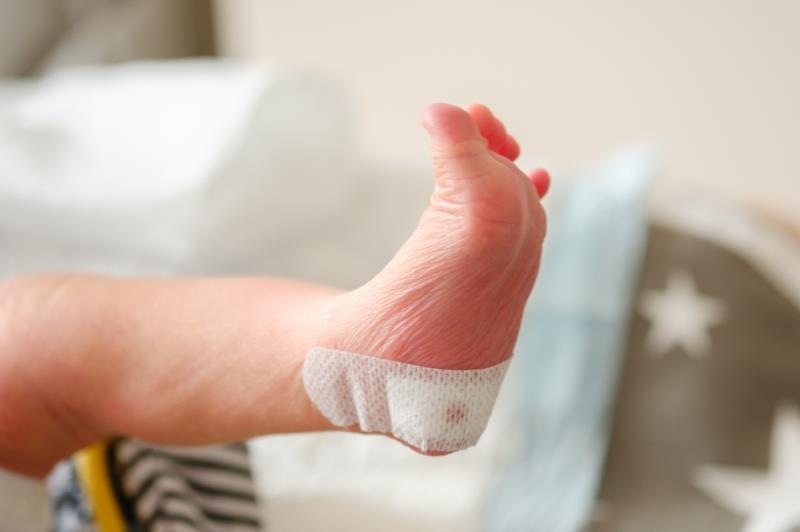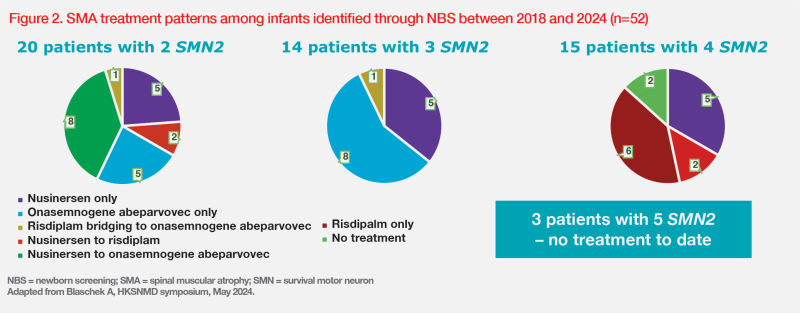Pre-symptomatic diagnosis and treatment: A game changer for SMA





Spinal muscular atrophy (SMA) is a progressive neurodegenerative disease that typically begins to manifest in infancy or childhood. Early diagnosis and prompt treatment before symptom onset can significantly improve clinical outcomes, including survival and attainment of motor milestones. At an industry-sponsored symposium co-organized by the Hong Kong Society of Neuromuscular Diseases (HKSNMD), Dr Astrid Blaschek of Dr von Hauner Children's Hospital in Munich, Germany, discussed implementation of the genetic newborn screening (NBS) programme for SMA in Germany and her clinical experience in managing children with SMA with available disease-modifying therapies, including risdiplam.
Genetic basis of SMA
SMA is an autosomal recessive disease caused by mutations in the survival motor neuron 1 (SMN1) gene, which result in low levels of the SMN protein, leading to motor neuron loss and progressive muscle weakness. A closely related SMN2 gene also encodes the SMN protein, but only approximately 10 percent of it is functional. In SMA, SMN protein is expressed exclusively from the preserved SMN2 gene, hence higher SMN2 copy numbers are typically associated with lower disease severity. However, it is recognized that SMN2 copy number is only a partial disease modifier, which does not perfectly predict clinical severity.
Varying numbers of SMN2 copies have been estimated among SMA subtypes: SMA type 1 (SMA1; one or two SMN2 copies in approximately 80 percent of patients), SMA type 2 (SMA2; three SMN2 copies in >70 percent of patients), and SMA type 3 (SMA3; three or four SMN2 copies in approximately 95 percent of patients). [Int J Mol Sci 2020;21:3297]
SMN-targeted therapies in Germany
In 2017, nusinersen, an antisense oligonucleotide, was approved in Europe as the first SMN-targeted therapy for SMA. “At that point, we started treatment in a 3-year-old symptomatic SMA patient, but there was inadequate improvement in her condition over the years and she required ventilation support,” shared Blaschek. “However, a 3-month-old infant who was treated immediately after SMA diagnosis had a much better response, displaying better head control, ambulating in a wheelchair, and not requiring breathing support.”
“In another case, we screened and initiated treatment in an asymptomatic 14-day-old infant who had two SMN2 copies. At the age of 11.5 months, he was walking and showed no clinical signs of weakness,” continued Blaschek. “Early diagnosis and pre-symptomatic treatment have been a game changer [for this disease].”
Currently, two other SMN-targeted therapies are available in Germany – onasemnogene abeparvovec gene replacement therapy, approved in 2020, and the oral small molecule, risdiplam, approved in 2021. (Figure 1) [Zolgensma Summary of Product Characteristics, May 2022; Evrysdi Summary of Product Characteristics, March 2021]

Switching from nusinersen to risdiplam
Once oral risdiplam became available, the parents of 18 symptomatic SMA patients (SMA1, n=4; SMA2, n=7; SMA3, n=7) receiving nusinersen in Germany opted to switch to risdiplam. This decision was driven by difficulties associated with nusinersen administration, such as occasional appointment cancellations or postponements by treatment centres, requirement for inpatient hospital admissions, and additional X-ray imaging or delays in nusinersen administration in patients with progressive scoliosis. [Blaschek A, HKSNMD symposium, May 2024]
“Most patients remained very stable after switching to risdiplam,” said Blaschek. “Previously, some patients would become less strong and shake more towards the end of the 4-month nusinersen dosing interval. These patients or their parents were happy to report a more stable course of disease after switching to risdiplam.”
Risdiplam only
“To date, there have been 17 previously untreated symptomatic SMA patients in Germany who started risdiplam. Over a 3-year observation period, risdiplam stabilized or at least slowed down SMA progression in these patients,” shared Blaschek.
Newborn screening and treatment of SMA
A pilot project of NBS for SMA was initiated in Germany in January 2018. Dried blood spot samples were collected from participating neonates 1–2 days after birth, and screening was performed with a short turnaround time of <24 hours per sample. Parents were informed of positive screening results and referred to a neuropaediatric centre, where the results were confirmed and SMN2 copy number was assessed by an independent laboratory. [Eur J Hum Genet 2020;28:23-30]
“It is important to notify the parents, ideally, on the day of receiving test results or no later than the day after,” emphasized Blaschek. “This will accelerate re-testing, SMN2 copy number estimation and initiation of therapy.” In October 2021, the pilot project was expanded into the general nationwide NBS programme in Germany.
Among the 52 SMA patients identified through NBS between 2018 and 2024, treatment patterns differed according to SMN2 copy numbers. (Figure 2)

“Once patients with two SMN2 copies start to manifest symptoms, especially in the early days of life, normal motor development is unlikely. In addition, for pre-symptomatic infants, there are no reliable biomarkers that can accurately predict disease course,” said Blaschek. “Whilst we measure CMAP [compound muscle action potential] and deep tendon reflexes, and perform CHOP INTEND [Children’s Hospital of Philadelphia Infant Test of Neuromuscular Disorders], we do not rely on those results and treat our patients as early as we can.”
In light of this, new German SMA guidelines have proposed a “bridging” strategy – immediate therapy in case of subtle symptoms before confirmatory diagnostic results – to be implemented after the screening diagnosis on day 6 until the copy number is established. [Blaschek A, HKSNMD symposium, May 2024]
According to this recommendation, one of Blaschek’s patients, an asymptomatic infant with three SMN2 copies was treated with risdiplam bridging therapy for 3 weeks before receiving gene therapy. Currently, at 5 months, he shows normal development.
Another of Blaschek’s patients, who has two SMN2 copies and was symptomatic at first presentation (on day 6), received risdiplam bridging therapy for 3 days followed by nusinersen as standard therapy. This patient developed signs of clinical hypotonia on day 14. “This experience demonstrates that once the [disease] process has started, it will hinder normal development,” pointed out Blaschek.
Considerations for SMA patients with four SMN2 copies
Previous guidelines suggested a watchful waiting strategy for SMA patients born with ≥4 SMN2 copies, as these patients do not typically present as early or with equally severe signs of SMA as patients with lower copy numbers. [J Neuromuscul Dis 2018;5:145-158]
“Patients with ≥4 SMN2 copies are not a very well understood cohort, and early stages of SMA3 can be missed during routine assessments,” cautioned Blaschek. “These children sometimes have normal findings on deep tendon reflexes, myosonography and CMAP, and the only proof of disease onset would be evidence of a neurogenic pattern in an electromyogram.”
“The watchful waiting strategy is not very practical or easy to implement for these patients, as parents may not see the value of frequent check-ups while there are no obvious symptoms, and may stop bringing their children to the clinic until there is symptomatic evidence of disease onset,” added Blaschek.
A long-term follow-up study among 15 SMA patients with four SMN2 copies identified in German NBS projects showed that a large proportion of infants (n=5/7), whose families decided to postpone treatment, became symptomatic within the first 4 years of life. [J Neuromuscul Dis 2022;9:597-605] In line with this, a retrospective analysis of 268 patients from Germany, Austria and Switzerland with four copies of SMN2 from the SMArtCARE registry provided further evidence on the natural history of disease progression. More than half of the cohort (55 percent) experienced symptom onset by the age of 3 years, and almost 95 percent were affected by the disease by the age of 18 years. In addition, a third of ambulatory patients lost their ability to walk without assistance by the age of 54 years, and nearly 16 percent of patients were never able to walk independently. [J Neurol 2024;271:2787-2797]
These data underscore the importance of early initiation of treatment in this subgroup of SMA patients. In 2020, the guidelines were updated for treatment to be initiated immediately in infants diagnosed with SMA via NBS with four copies of SMN2. [J Neuromuscul Dis 2020;7:97-100]
Treatment decisions in 2024
“All available treatments can restore the missing SMN protein at the molecular level, but timing of treatment is important for its effectiveness, as damaged motor neurons regenerate poorly, even when SMN protein is restored,” noted Blaschek. “Switching treatment doesn’t necessarily change the course of the disease. This decision should be based on safety, administration profile, individual families’ preference and convenience, and the need for bridging.”
Summary
Early diagnosis, ideally before symptom onset, and immediate treatment are crucial for improving SMA outcomes. NBS allows SMA diagnosis in presymptomatic infants, thus maximizing the potential benefit of any treatment through early initiation. This proactive approach with early treatment initiation should be offered to all SMA patients regardless of SMN2 copy number.